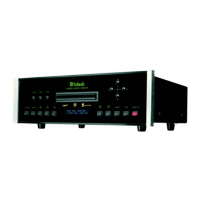MS300 Advanced Users Guide
3/3/2005
Page 20 of 65
2 Chambers Street • Binghamton, NY 13903-269 Phone: 607-723-3512 / 800-538-6576 • Fax: 607-724-0549
Technical Support 866-458-6910 9:00AM to 6:00PM EST, M-F www.mcintoshlabs.com
What is FLAC?
FLAC stands for Free Lossless Audio Codec. Grossly oversimplified, FLAC is similar to
MP3, but lossless, meaning that audio is compressed in FLAC without any loss in
quality. This is similar to how Zip works, except with FLAC you will get much better
compression because it is designed specifically for audio, and you can play back
compressed FLAC files just like you would an MP3 file. The quality of a FLAC encoded
file is an exact bit for bit copy of the original CD audio data. MP3 encoded files are not
bit for bit copies of the original audio and therefore technically don’t equal the quality of
the original.
FLAC is freely available and supported on most operating systems, including Windows,
"unix" (Linux, *BSD, Solaris, OS X, IRIX), BeOS, OS/2, Mac OS X, and Amiga.
Notable features of FLAC
• Lossless: The encoding of audio (PCM) data incurs no loss of information, and
the decoded audio is bit-for-bit identical to what went into the encoder. Each
frame contains a 16-bit CRC of the frame data for detecting transmission errors.
The integrity of the audio data is further insured by storing an MD5 signature of
the original unencoded audio data in the file header, which can be compared
against later during decoding or testing.
• Fast: FLAC is asymmetric in favor of decode speed. Decoding requires only
integer arithmetic, and is much less compute-intensive than for most perceptual
codecs. Real-time decode performance is easily achievable on even modest
hardware.
• Hardware support: Because of FLAC's free reference implementation and low
decoding complexity, FLAC is currently the only lossless codec that has any kind
of hardware support.
• Streamable: Each FLAC frame contains enough data to decode that frame. FLAC
does not even rely on previous or following frames. FLAC uses sync codes and
CRCs (similar to MPEG and other formats), which, along with framing, allow
decoders to pick up in the middle of a stream with a minimum of delay.
• Seekable: FLAC supports fast sample-accurate seeking. Not only is this useful for
playback, it makes FLAC files suitable for use in editing applications.
• Flexible metadata: New metadata blocks can be defined and implemented in
future versions of FLAC without breaking older streams or decoders
• Suitable for archiving: FLAC is an open format, and there is no generation loss if
you need to convert your data to another format in the future. In addition to the
frame CRCs and MD5 signature, flac has a verify option that decodes the encoded
stream in parallel with the encoding process and compares the result to the
original, aborting with an error if there is a mismatch.
• Convenient CD archiving: FLAC has a "cue sheet" metadata block for storing a
CD table of contents and all track and index points. For instance, you can rip a
CD to a single file, then import the CD's extracted cue sheet while encoding to

